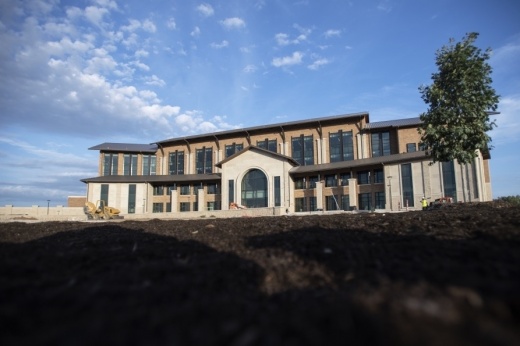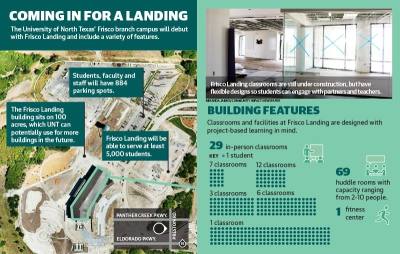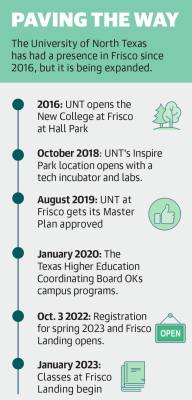It will be the first time Collin County has a Tier 1 Carnegie research institution, officials said, the top tier for a research-focused university.
Frisco Landing, the first building of the new branch, will open for the spring semester next year at the southwest corner of Panther Creek Parkway and Preston Road. When it opens, it will not only showcase a design intended to promote collaboration and communication between students, but also provide a hub for growth opportunities through supporting programs and partnerships, officials said.
“The purpose of the Frisco campus is to close the gap between higher education and employers,” UNT President Neal Smatresk said. “It was designed very intentionally to welcome employers in, to have employers be engaged not just in recruiting students but potentially engaged in helping to develop curriculum or teaching classes, or to be guiding students and helping in their professional development.”
About the campus
UNT has been offering classes in Frisco since 2016 at Hall Park and Inspire Park. Prior to this, there was no four-year institution in Collin County.
Frisco Landing is expected to offer classes in 27 undergraduate and master’s level programs, from biology to sport entertainment management.
A guiding principle for the design of Frisco Landing was creating future-proof classrooms, Smatresk said. This was done through design and construction in addition to curriculum development. A team of faculty, students and staff members compiled the values and the statements the new campus should embody, Smatresk said.
This includes incorporating HyFlex classrooms, he said. HyFlex classrooms are designed with features to allow students to work in small groups or listen to a lecture in a traditional style. Computers or screens are available around the room so students can work interactively or attend virtually.
“Not everyone is capable of going to every class all the time, and so if your work schedule or personal life schedule doesn’t support that, we’ve built classrooms that make it easy to still be part of the community,” Smatresk said.
Throughout the campus a commitment to collaboration is apparent with open spaces, maker spaces and lounge areas. The first floor features larger classrooms and provides access to outdoor spaces, such as an amphitheater and workout areas.
The second floor features the learning center and library as well as smaller huddle rooms dedicated to testing and tutoring. Staff said these areas showcase the university’s commitment to project-based learning, compounded by the fact that there are no offices on most of the floors.
“That’s kind of a big shift in learning is not going to your office for meetings,” said Jeannine Vail, senior project manager of the University of North Texas System, during a May tour of Frisco Landing. “The idea is that you have class and you might have questions before or after, and you just pop into the huddle room with the faculty member and you start working. Maybe you stay there as a student with your friends and you’re working on projects afterwards. That’s the goal.”
Balconies surround the upper floors and provide additional gathering spaces for students and faculty, Vail said. The third and fourth floors of the building have a smaller footprint than the lower floors and are primarily for classrooms and huddle rooms. No particular floor is dedicated to one area of study, she said. Rather, students travel throughout the building to get to their classes.
“It kind of forces students to go different places,” she said during the May tour. “I think it’s great if classes can be mixed around and get students to go see other things.”
Creating a landing space
Creating the building concept was a lengthy process, Smatresk said, and one that involved the active engagement of students and staff.
The third floor will demonstrate this involvement with a UNT branding element created by a student. Normally, the university hires a professional sculptor to create something for the campuses, but for this building UNT officials decided to tap the talent of Archit Karkare, a student in the art department. He is now working with a fabricator in Denton on a sculpture idea he submitted, he said.
His sculpture will consist of three eagle feathers—a tribute to UNT’s eagle mascot—spiraling upwards. It will be made out of aluminum and polyester fabric threads, and it will be suspended from the ceiling.
“My concept behind the proposal was this idea that UNT is a place, at least for me, where I challenge myself and try to push myself higher,” he said.
Iyke Ifeji, a student at UNT at Frisco’s Hall Park campus, said he shared his opinions as well and provided input on the UNT at Frisco website. He said the new facility will have more of a college feel.
“Having a wide open campus with all these new resources [and] all these new rooms, like the fabricator room where you can 3D-print stuff, that’s something that I’m looking forward to,” he said.
Gabi Carden, a student worker at UNT, said the new facility opens up more opportunities for high school students. As a graduate of Heritage High School in Frisco, she said she was able to see firsthand the diversity and creativity from students. The new facility will provide key educational opportunities for these students right at home, versus them having to travel for school, she said.
“There’s a lot of creative minds and a lot of smart minds that are coming out of these districts ... that are going to funnel into UNT at Frisco and really create that dynamic environment that it’s always been about,” she said.
Seth Ketron, clinical assistant professor of marketing for UNT at Frisco, teaches at the Hall Park location. He said the new location not only opens up access for students to get a quality education in their own backyards, but it also creates additional opportunities to partner with companies headquartered in and around Frisco.
Frisco Landing will serve as the core operational base for project-based learning programs that are offered exclusively in Frisco, such as its Applied Project Design and Analysis program, Ketron said. Also launching in the fall is UNT at Frisco’s new Bachelors of Science in Industrial Distribution degree. The degree field applies math, science, engineering technology, business, data processing, communications and more skills, according to the UNT website. The ultimate goal is to give students relevant, hands-on experience to gain a competitive edge in the job market, officials said.
“[Students] are learning a set of universal skills that help them solve real-world problems,” Ketron said.
Project-based learning programs require students to work with industry partners, which range from JPMorgan Chase, Liberty Mutual, American Airlines and the Dallas Cowboys to local nonprofits. Throughout the program, students work to solve problems presented by the partners. Problems might be related to user experience, product design or branding.
“Hall Park is nice. Everything is modern and updated, but it doesn’t have all the pullout rooms or the kind of design where you can really make use of the small team space like you would want to,” Katron said.
Next steps
This fall, university officials plan to make some announcements related to the unveiling of the Frisco Landing building, Smatresk said. In fall 2021, 2,638 students were enrolled in UNT at Frisco, and that number is expected to grow.
risco Landing will be able to serve at least 5,000 students. At this time there are no plans to construct additional buildings, Smatresk said, since construction funding hinges on decisions made at the Texas Legislature.
“The next time there’s a legislative opportunity for us to add to the campus, we’ll be looking at that as an opportunity to launch a major effort, possibly moving some of the programs from [Denton], which is getting very space-bound out to the Frisco campus,” Smatresk said.







